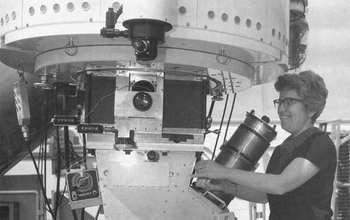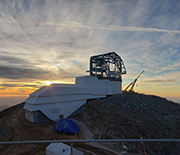NSF-supported observatory renamed for astronomer Vera C. Rubin – National Science Foundation
News Release 20-001
First national U.S. observatory to be named after a woman

The Rubin Observatory will significantly advance what we know about dark matter and dark energy.
January 7, 2020
The Large Synoptic Survey Telescope will now be called the NSF Vera C. Rubin Observatory, making it the first national U.S. observatory to be named after a female astronomer. Announced at the 2020 American Astronomical Society winter meeting, the name recognizes the role Rubin played in better understanding dark matter, which will be one of the observatory survey’s four main themes.
“Named after an astronomer who provided important evidence of the existence of dark matter, the NSF Vera C. Rubin Observatory seems destined to make science history with its extraordinary capabilities that will come to bear in the next few years,” said France Córdova, National Science Foundation director. “Congress has helped make this inspiring commemoration a reality. The Rubin Observatory is expected to significantly advance what we know about dark matter and dark energy, so the Rubin name will have yet another way to inspire women and men eager to investigate.”
The initiative to rename the observatory was started in June 2019 by House Science, Space and Technology Committee Chairwoman Eddie Bernice Johnson and Congresswoman Jenniffer González-Colón and was enacted into law on Dec. 20, 2019.
Science operations at the Rubin Observatory, located on Cerro Pachón in Chile, will start in 2022. The observatory consists of an integrated system featuring a wide field ground-based telescope with an 8.4-meter mirror, a 3,200-megapixel camera built by the Department of Energy, an automated data processing system, and an online public engagement platform. The construction and operations of the Rubin Observatory and its DOE LSST Camera is a U.S. federal partnership of NSF and DOE, with private and international contributors.
“It is fitting for this major new observatory, which includes the study of dark matter and dark energy as one of the major research topics, to be named for a pioneering astronomer whose observations were so critical to our understanding of this area,” said Paul Dabbar, DOE undersecretary for science. Dr. Rubin’s life and singular achievements as a scientist remain a model for all those seeking to satisfy humanity’s unceasing curiosity about our universe.”
During its first 10 years, this system will deliver an unprecedented optical survey of the visible sky – to be named the Legacy Survey of Space and Time. The survey’s design is driven by four themes: probing dark energy and dark matter, taking an inventory of the solar system, exploring the transient optical sky, and mapping the Milky Way.
“We are deeply honored to have the observatory named after Vera Rubin,” said Steve Kahn, the Rubin Observatory director. “Through her discovery of dark matter, Vera made one of the most important contributions to science in the past century, not only for astronomy, but also for fundamental physics. When construction is completed, the Rubin Observatory will build on her pioneering work to dramatically improve our understanding of the universe on many different scales.”
Vera Rubin’s work spanned several areas in observational astronomy, but she is most recognized for uncovering the discrepancy between the observed and predicted motions of matter in galaxies. This discrepancy is interpreted as evidence for dark matter, which exerts gravitational force but does not emit light. Her work was confirmed using numerous observational techniques, and it has had a major impact on cosmology.
Although Vera Rubin received many scientific honors, such as the National Medal of Science and being voted into the National Academy of Sciences, she experienced gender-based resistance early in her career. She was an outspoken advocate for women in the sciences, recognized for paving the way for other women in astronomy, and for achieving remarkable professional success while facing challenges that her male colleagues did not have to overcome. As both a scientist and a woman, she improved the field for those who came after.
“We are pleased LSST has now been named the Vera C. Rubin Observatory,” said sons Allan, David and Karl Rubin. “We believe that this is a great way to honor our mother’s achievements in astronomy and her work for equal rights for women in science.”
In addition, the telescope at the Rubin Observatory has been named the Simonyi Survey Telescope in recognition of a significant private donation made early in the construction phase used to design, develop and fabricate the telescope’s primary mirror.
The Rubin Observatory is a federal program of the NSF and DOE, with the NSF functioning as the lead federal agency and providing the majority of construction funding. In addition to NSF and Department of Energy funding, private funders also have shouldered some project construction costs through the LSST Corporation. The NSF-funded LSST Project Office for construction was established as an operating center under management of the Association of Universities for Research in Astronomy. The DOE-funded effort to build the LSST camera is managed by the SLAC National Accelerator Laboratory.
NSF and the DOE Office of Science will continue to support the Rubin Observatory in its operations phase to carry out the Legacy Survey of Space and Time. They will also provide support for scientific research. During operations NSF funding is managed by AURA under a cooperative agreement with NSF and DOE funding is managed by SLAC under contract by DOE. The Rubin Observatory is operated by NSF’s Optical-Infrared Astronomy Research Laboratory and SLAC.
-NSF-
-
NSF Vera C. Rubin Observatory at sunset in October 2019.
Credit and Larger Version
Media Contacts
Ivy F. Kupec, NSF, (703) 292-8796, email: ikupec@nsf.gov
The National Science Foundation (NSF) is an independent federal agency that supports fundamental research and education across all fields of science and engineering. In fiscal year (FY) 2020, its budget is $8.3 billion. NSF funds reach all 50 states through grants to nearly 2,000 colleges, universities and other institutions. Each year, NSF receives more than 50,000 competitive proposals for funding and makes about 12,000 new funding awards.
Useful NSF Web Sites:
NSF Home Page: https://www.nsf.gov
NSF News: https://www.nsf.gov/news/
For the News Media: https://www.nsf.gov/news/newsroom.jsp
Science and Engineering Statistics: https://www.nsf.gov/statistics/
Awards Searches: https://www.nsf.gov/awardsearch/







